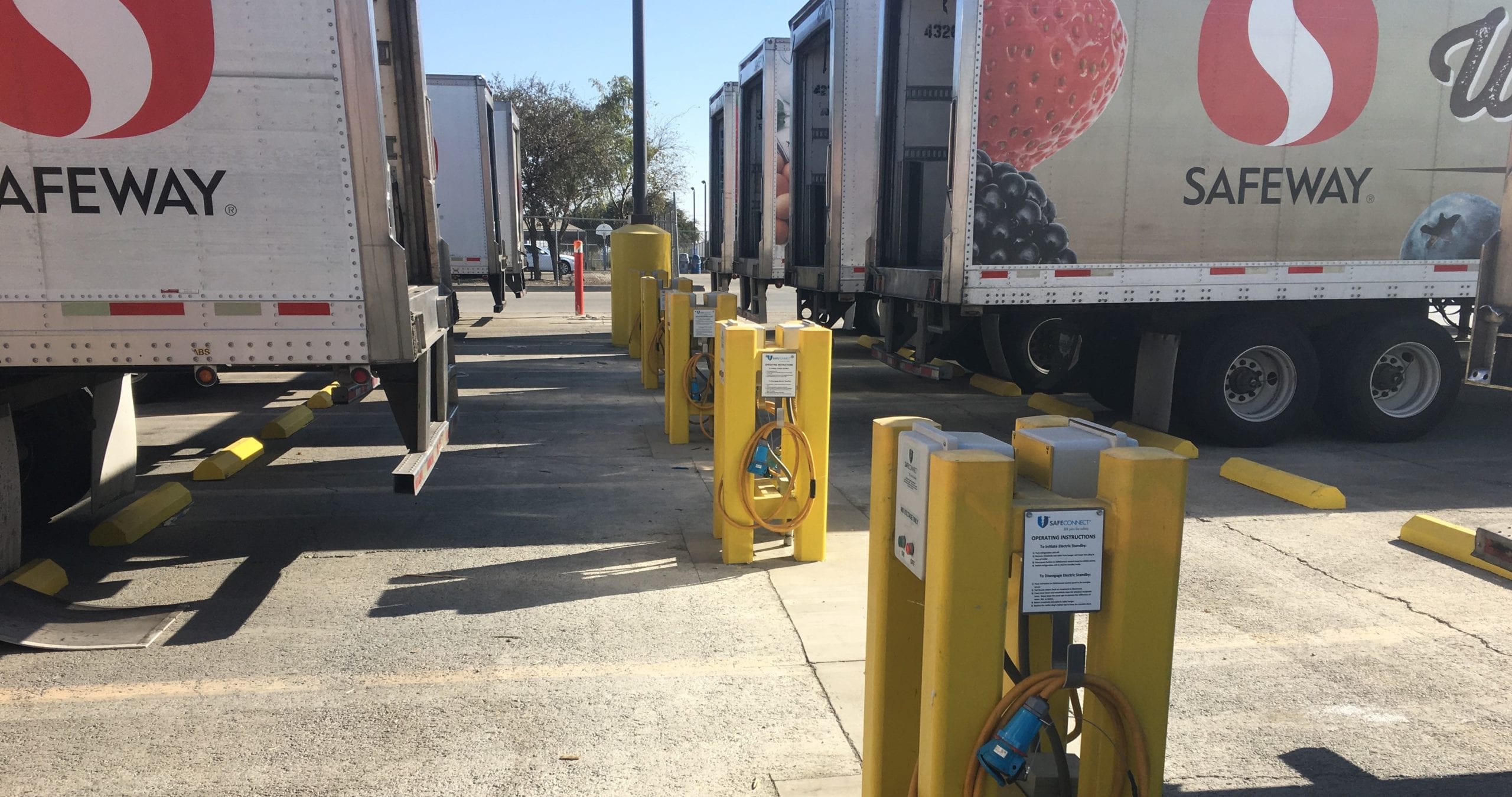In partnership with: Pacific Gas and Electric (PG&E)
Keeping things cool is just one of the priorities for national grocery store chain Albertsons Companies. At their 2.2 million square foot distribution center in Tracy, California, the company is converting its transport refrigeration units (TRUs) to electric to reduce emissions and save on operating costs—with the help of their local utility Pacific Gas & Electric Company (PG&E).
While electrification has been a part of the company’s sustainability plan for some time, recent goals set by both the California Air Resources Board (CARB) and Governor Gavin Newsom also support the grocer’s previously initiated eTRU plans.
PG&E is helping Albertsons to reduce emissions and save on operating costs by converting TRUs to electric.
Regulation Impact on Fleets
Because TRUs are a major contributor to toxic air pollutants, particularly in low-income communities, CARB is targeting this sector for early transition to zero emission. Early last year, the clean air agency developed a measure that would mandate California fleets operating TRUs to both transition to zero emission technology and install the infrastructure needed to power this equipment. Then in September 2020, Governor Newsom issued an Executive Order requiring CARB to draft a mandate to transition off-road vehicles and equipment, such as TRUs, to 100% zero emission by 2035.
Based on this new direction, CARB is reconsidering its existing zero emission TRU regulation, with a new draft expected to be published in the fall of 2021. There are early indications that this update could have major impacts on plans to deploy eTRUs. One such effect is whether “hybrid” eTRUs – such as those used by Albertsons at its Tracy location, which run off electricity when plugged into a battery or charging port and are powered by the diesel truck when on-road – will be considered compliant by CARB. Given off-road equipment, including eTRUs, will be required to go zero emission by 2035, the trucks they run off are not required to transition until 2045 in the Governor’s Executive Order. CARB’s pending Advanced Clean Fleets regulation could accelerate this timeline for certain vehicles, but currently this leaves a decade between when eTRUs are expected to be fully zero emission—meaning they don’t run off an internal combustion engine and when the medium- and heavy-duty electric vehicles needed to power these units may be fully commercially available to fleets.
While the anticipated changes to the regulation present some new challenges for fleets, what remains consistent is that the current hybrid eTRU technology significantly helps fleets reduce TRU emissions today. And while a transition to fully zero emission in the future is inevitable, fleets can use hybrid eTRUs to test the new technology and scale up deployment over time. Albertsons serves as a model to other fleets on how to pilot eTRU technology while preparing for an electric future.
CARB is reconsidering its existing zero emission TRU regulation, with a new draft expected to be published in the fall of 2021.
A Work in Progress
Of the more than 750 refrigerated trailers that move groceries in and out of Albertsons’ distribution center, 280 have been converted to eTRUs produced by manufacturer Carrier Transicold. With fully electric refrigeration units still years away from being commercially available, utilizing this hybrid technology enables the grocer to begin reducing emissions immediately; while providing the foundation for full zero emission operations in the future as the units can either be moved to electric vehicles or run off an additional onboard battery, and can utilize the EV charging infrastructure installed today.
After initially setting project goals to reduce emissions, realize lower total cost of ownership, and gain a better understanding of what deploying and operating eTRUs entails, Albertsons then surrounded itself with project partners who could help implement its vision.
PG&E’s engineering and construction teams—along with contractor Hansen Rice and charger manufacturer SafeConnect Systems—worked to plan, deliver, and install 25 SafeConnect eTRU single port chargers at 15 of the distribution center’s loading docks, as well as five dual port chargers in the staging areas. The infrastructure took about eight months to install and was completed in November 2019. This initial phase helped Albertsons test the technology at the site’s busiest loading docks to maximize the charging time for the eTRUs and help determine how to optimize future charging infrastructure installation. Based on these lessons learned, the fleet anticipates that completing a new project of the same size would take half the time.
Albertsons serves as a model to other fleets on how to pilot eTRU technology while preparing for an electric future.
Lessons Learned from an Early Adopter
As one of the first fleets to deploy eTRUs, Albertsons learned lessons during its project that will help fleets more easily and cost-effectively complete their projects in the future. One such example is that due to the nature of food and beverage delivery schedules, it’s not always possible to match an eTRU trailer with an electrified loading dock. To maximize the use of on-site charging, a fleet should either install eTRUs on all trailers or charging equipment on all loading docks.
Additionally, there is a need for an industry-wide standard for eTRU connectors for dock ports and trailers. This standardization would reduce costly retrofits on various types of trailers later in the project. In addition, there is a need for automated and simplified data collection processes along with proper monitoring of granular power metered data for every port to accurately measure energy load and cost.
PG&E played an important role in helping the fleet work through some of these challenges throughout the project. Partnering with the utility early on can help fleets avoid costly project delays when installing their infrastructure.
Emission Reductions and Cost Savings Achieved
After one full year of operating the eTRUs at the facility, Albertsons projects an annual savings of approximately $62,000 per year, compared to diesel technology, when charging at the $0.16 per kilowatt-hour utility rate. The company also saw reduced overall maintenance costs with none of the eTRU ports requiring repairs during the project period.
Meeting its goal to provide cleaner air for the community, the eTRUs reduced greenhouse gas emissions by 77% and NOx emissions per hour of usage by 98%, while also significantly diminishing noise pollution. And while the emissions reductions were only realized at the Tracy facility for this project, the eTRU trailers can be used at any grocery store that has compatible charging ports providing additional air quality benefits to all communities the eTRUs operate in throughout the state.
To learn more about Albertsons’ project read the full case study.
Albertsons projects an annual savings of approximately $62,000 per year, compared to diesel technology for TRUs.
Looking to the Future
As part of its ongoing efforts to decrease carbon emissions and run a cleaner transportation program, Albertsons is working to electrify even more of its operations. In 2018, the company announced plans to deploy 10 all-electric Tesla tractors for its Southern California fleet and continues to test eTRU operations to add even more units to its fleet.
While electric vehicle and TRU technology are still in their early stages, fleets that start today will get an early advantage by accessing the funding and support that is currently available to help early adopters. As part of PG&E’s EV Fleet program, fleets operating eTRUs can receive $3,000 per unit to put towards the cost of charging infrastructure installation. Additionally, those that deploy EVs along with the units can receive between $3,000 to $9,000 per EV based on vehicle type. Furthermore, those based in disadvantaged communities are eligible for rebates on the chargers themselves. This is in addition to the cost savings realized through PG&E’s support during the actual design and construction phase of the project.
The EV Fleet program is available to fleets through the end of 2024. With most EV projects taking fleets on average two years to complete, right now is the time to start. To get help with your electrification plans, submit an interest form to connect with an EV Fleet specialist. And learn more about eligibility requirements, additional funding opportunities, infrastructure best practices, and more at pge.com/evfleet.



